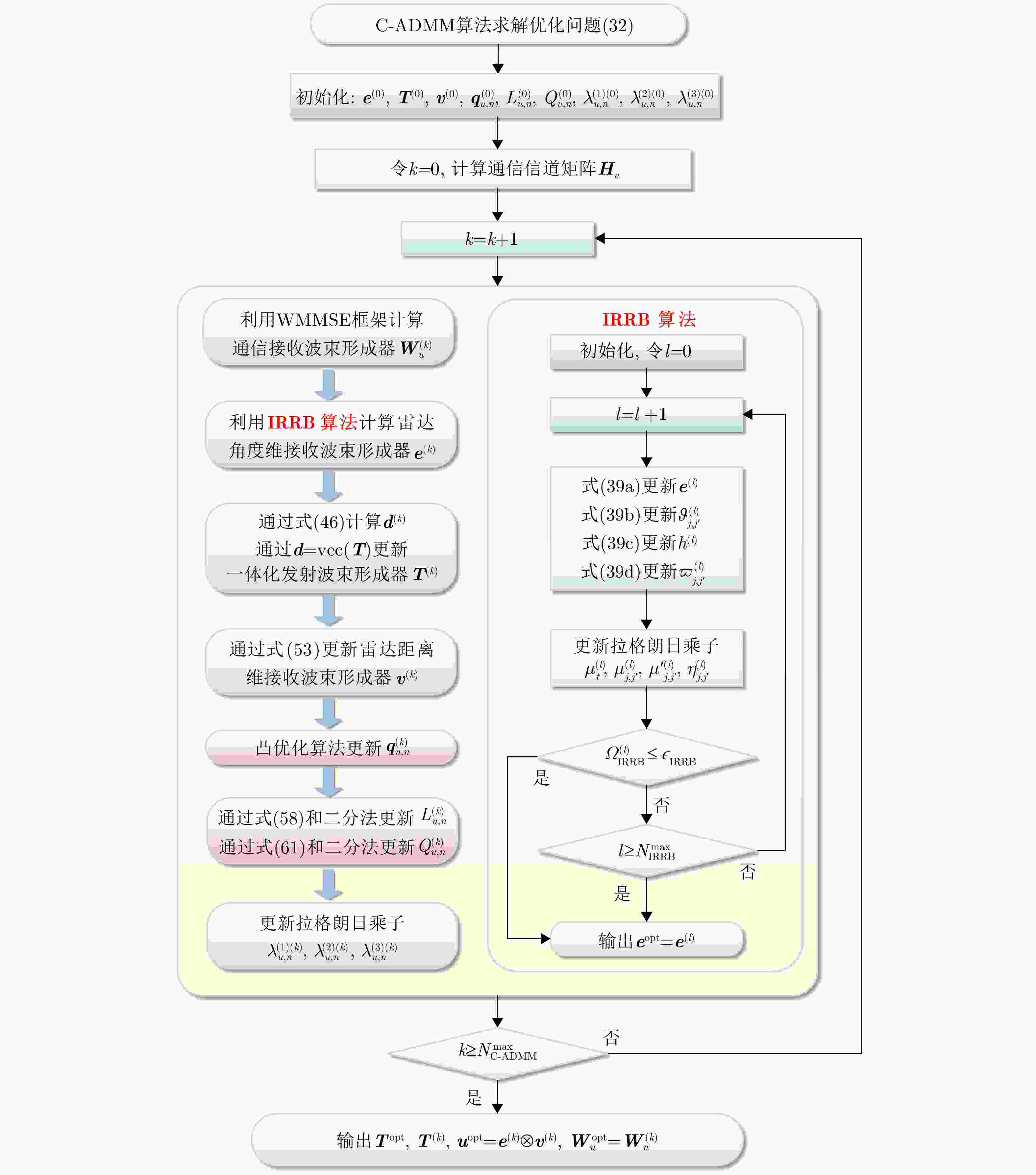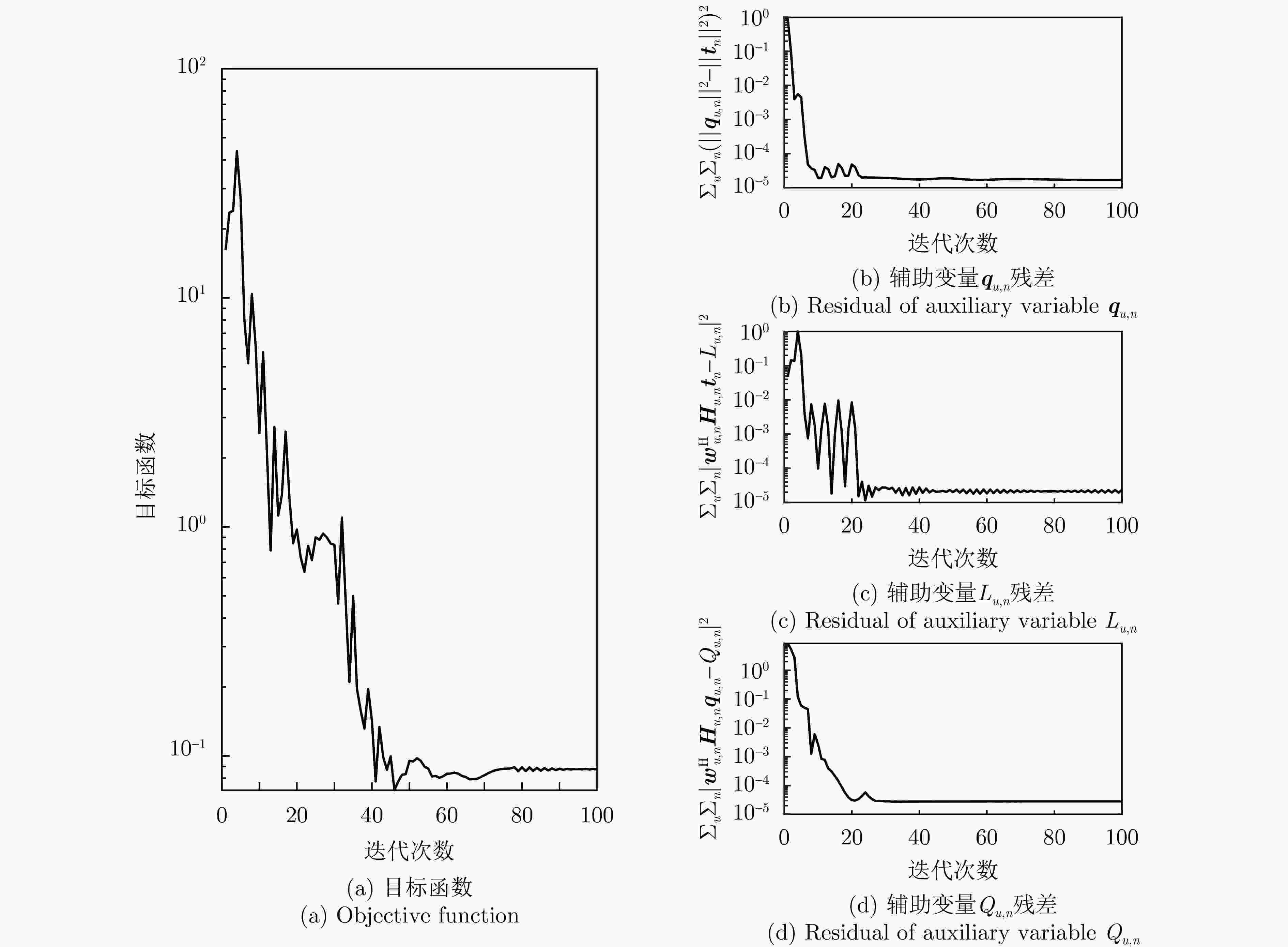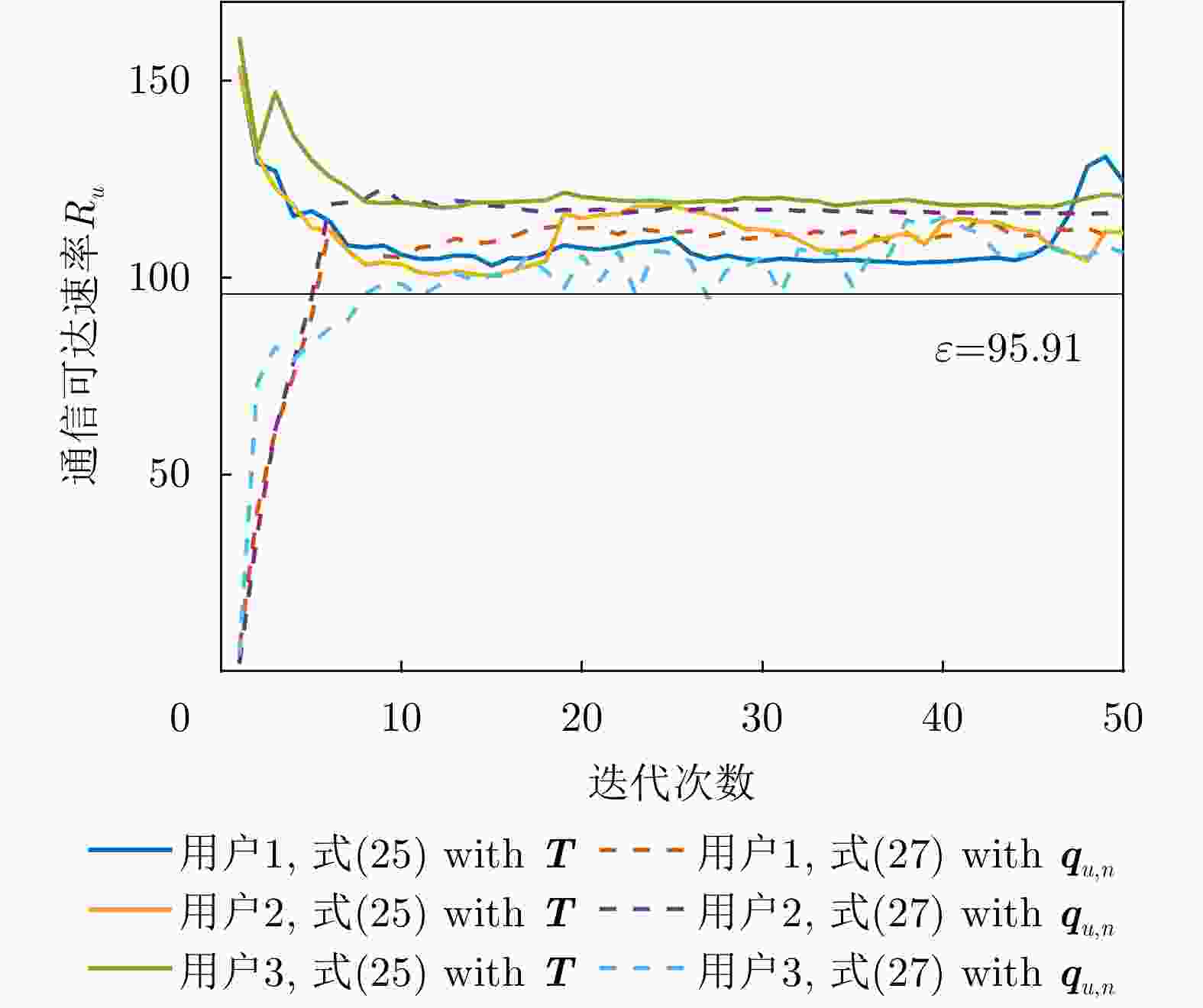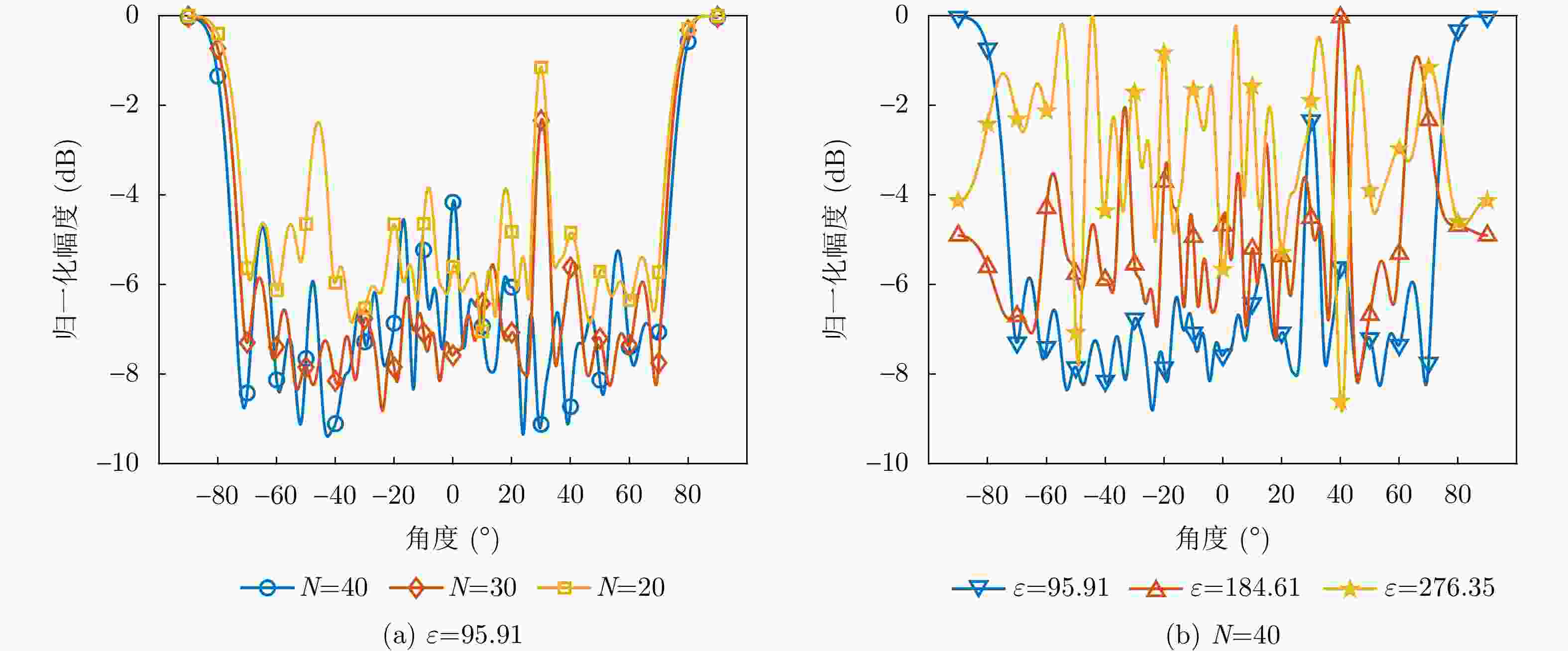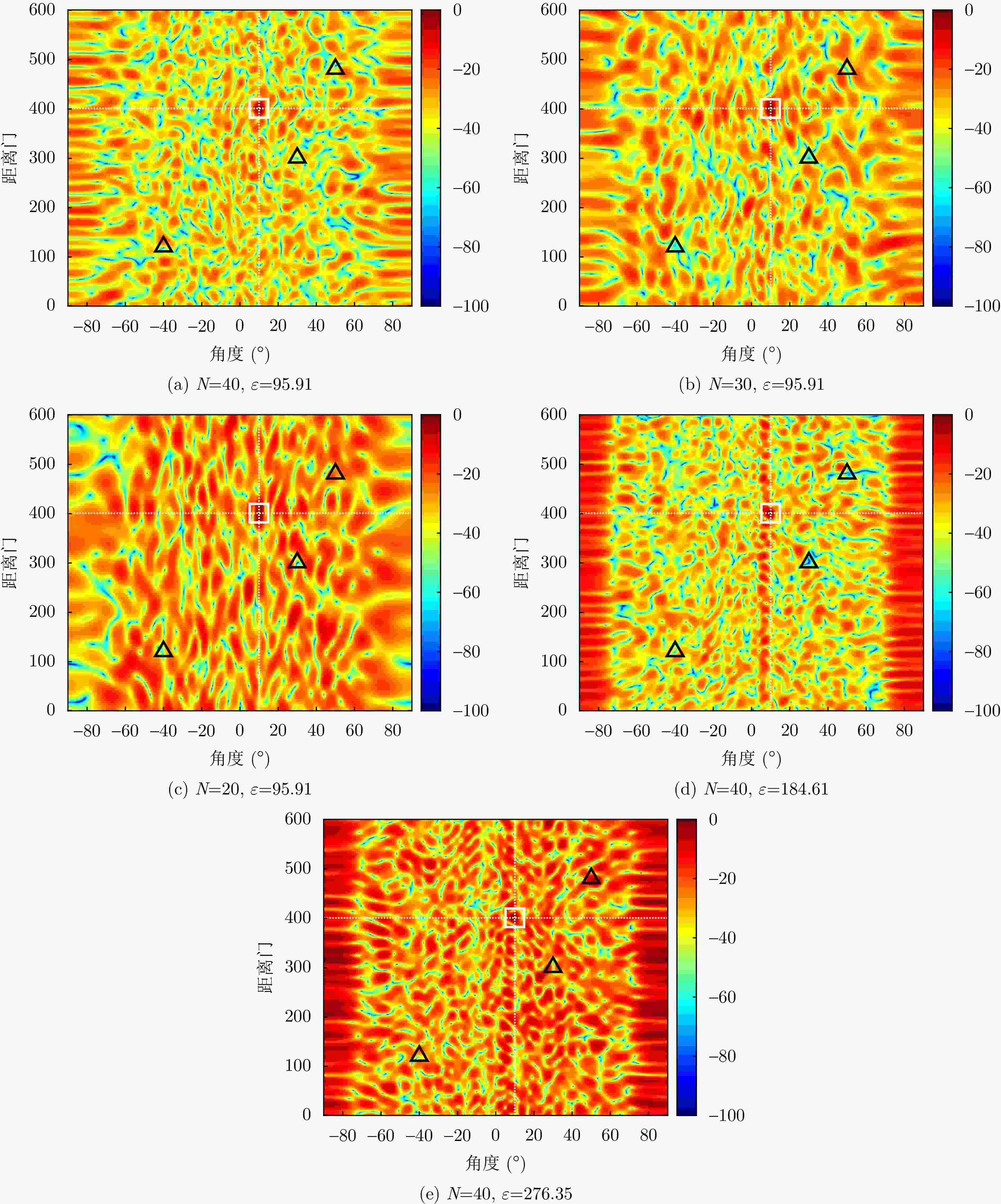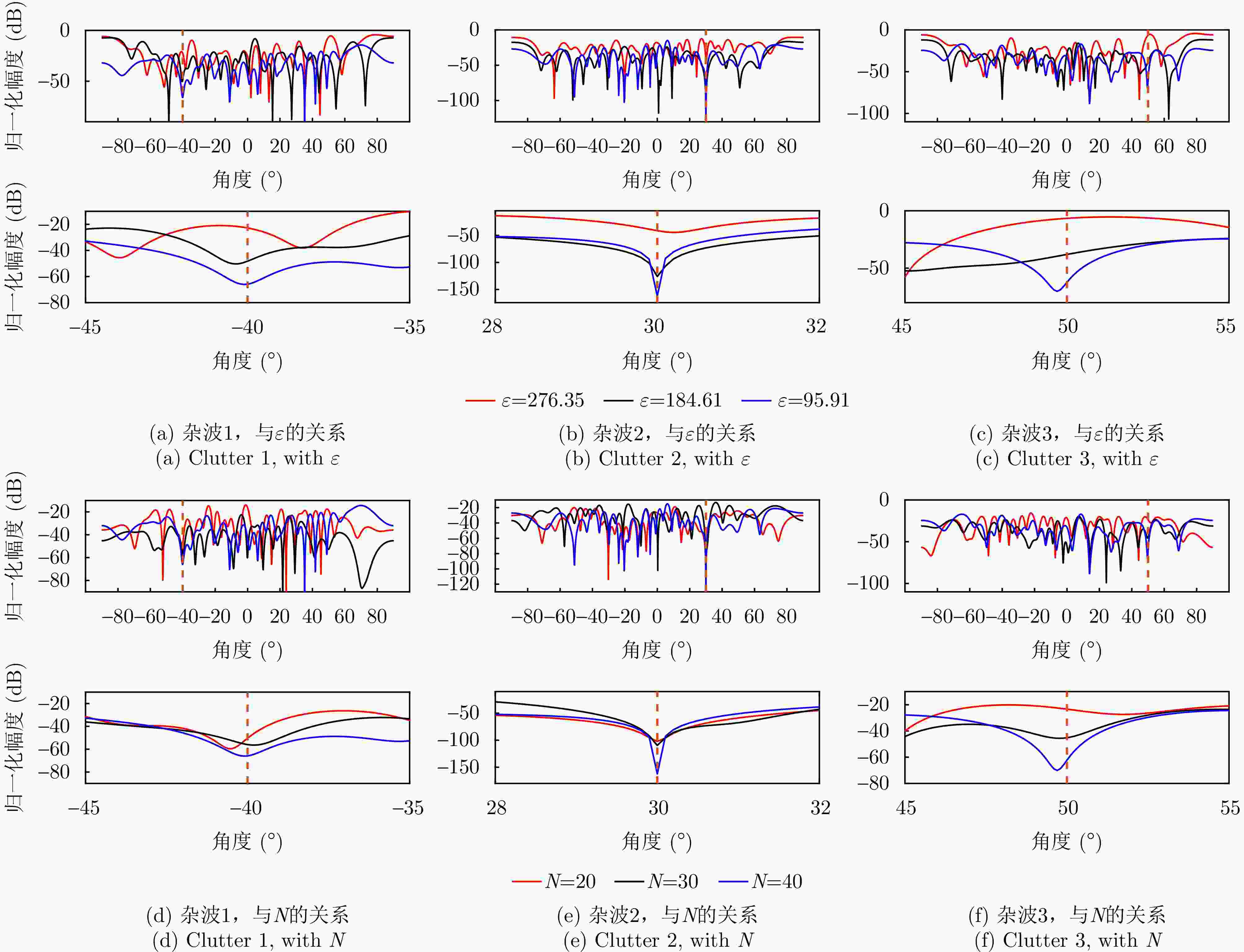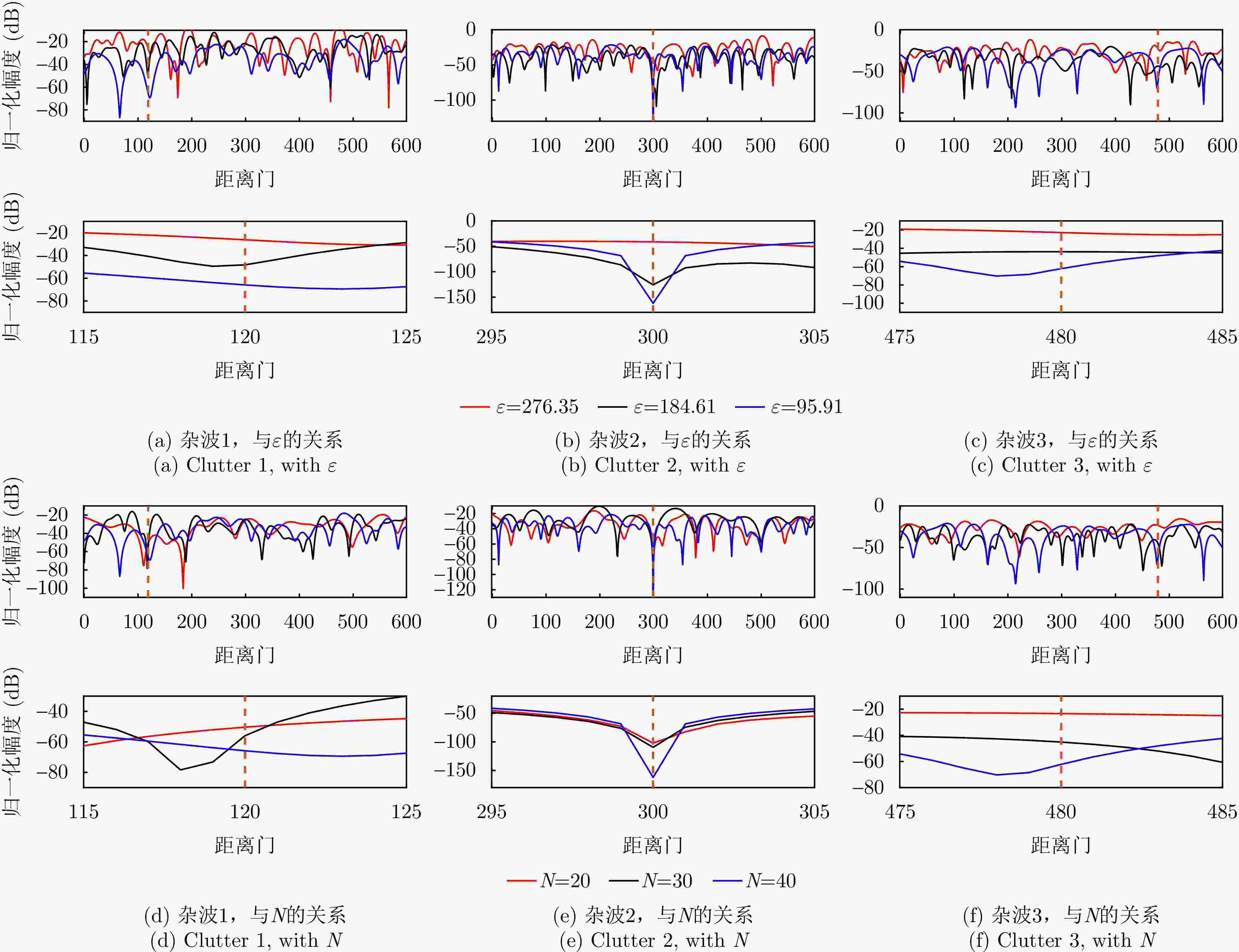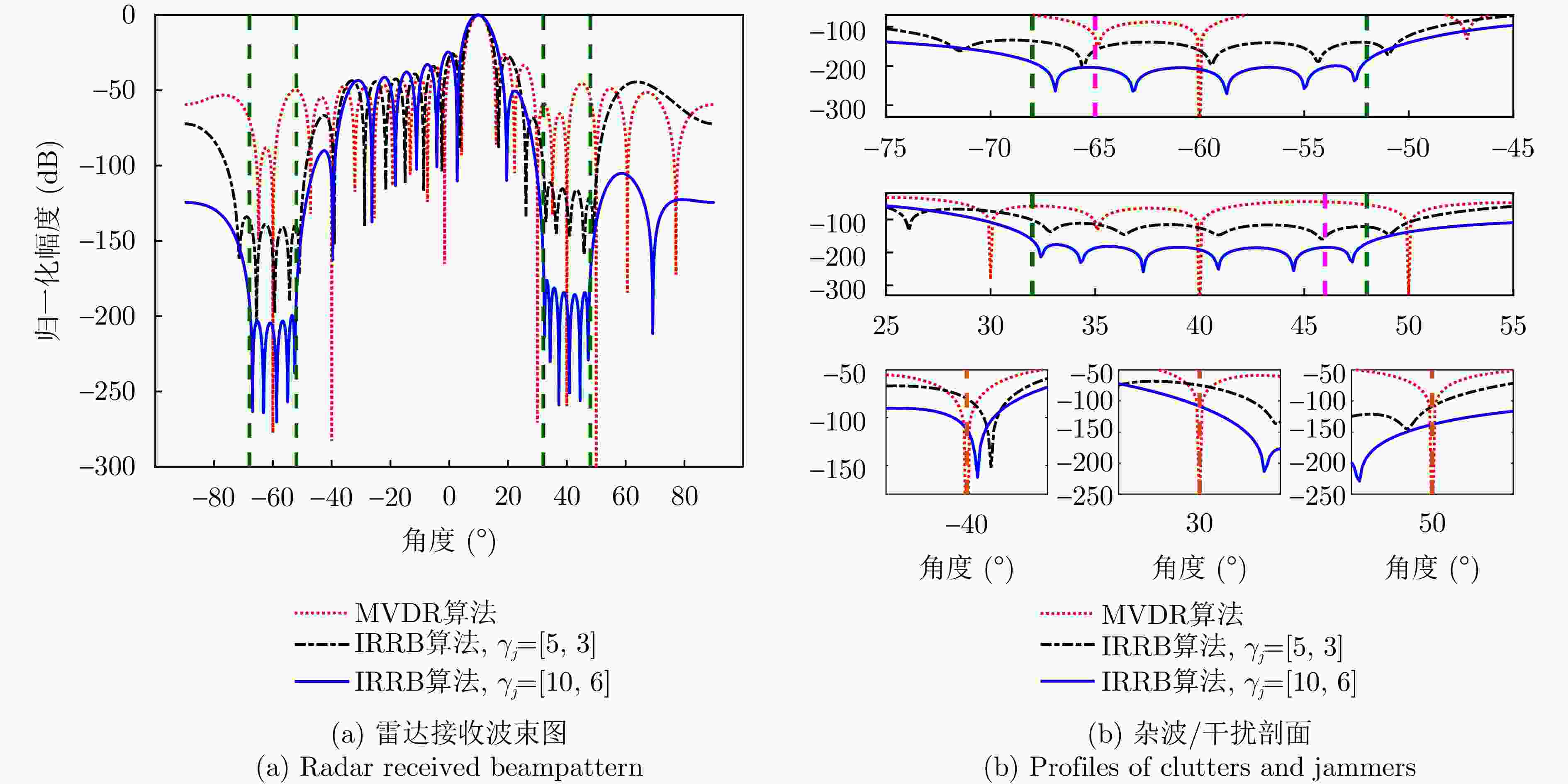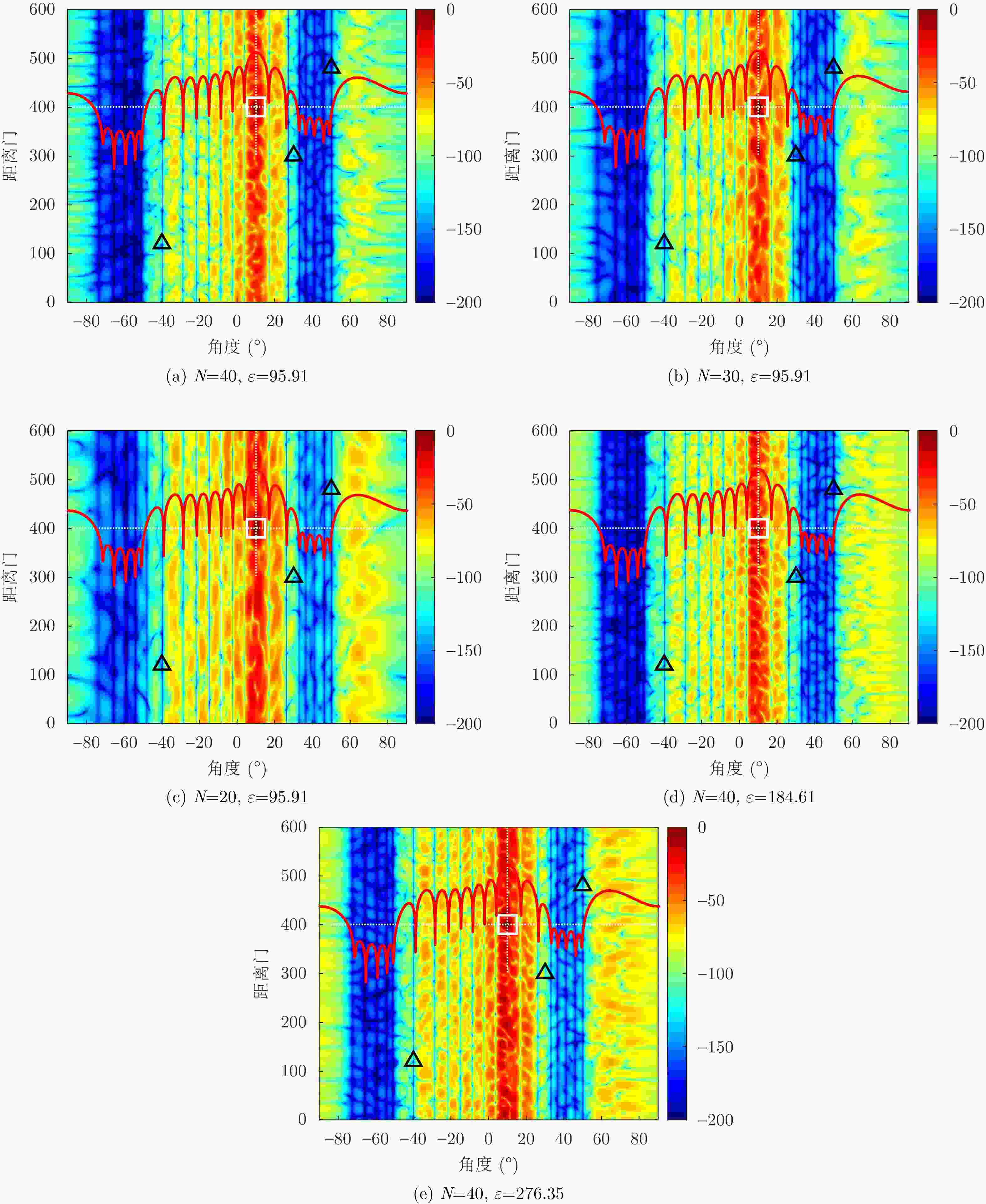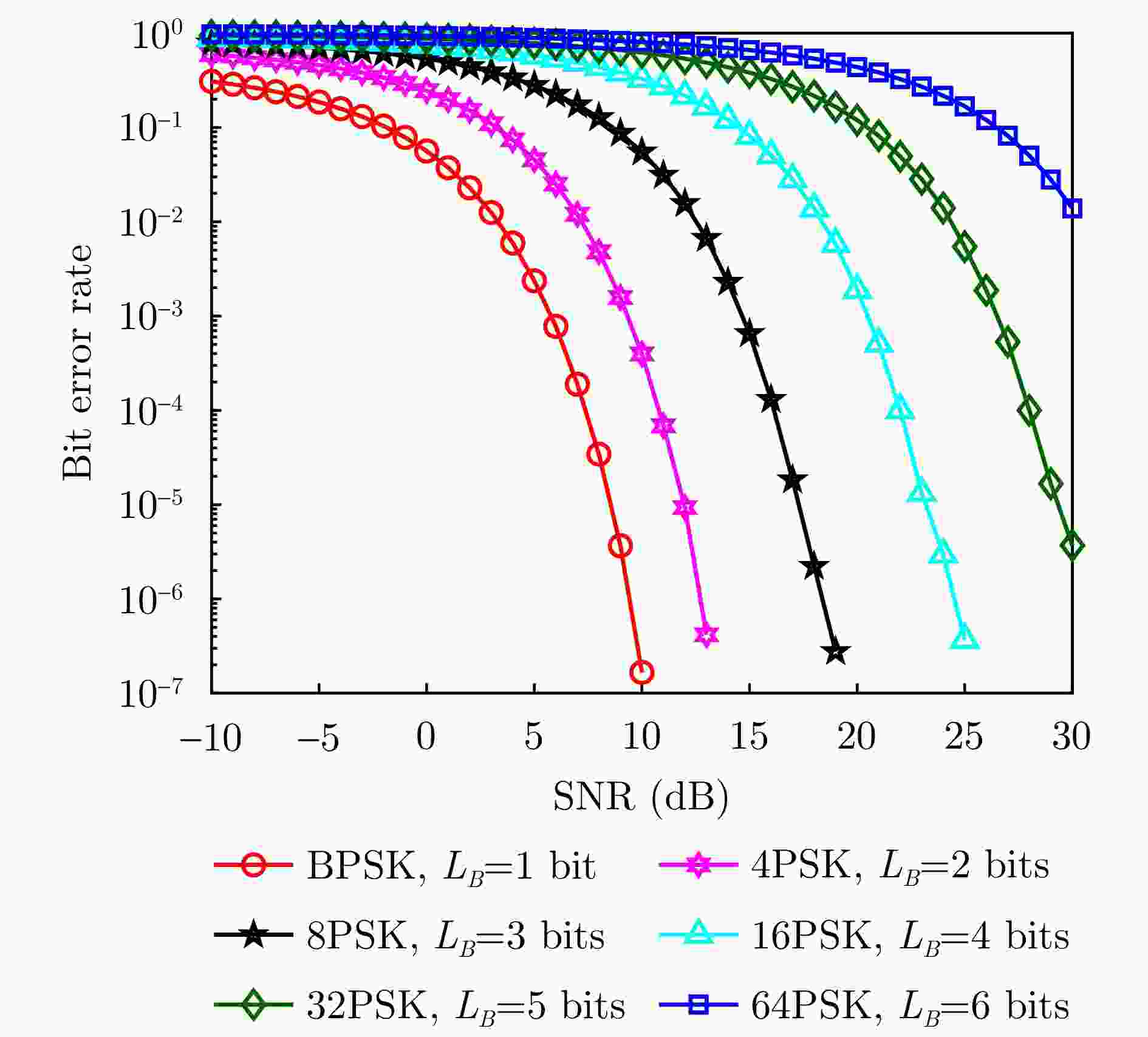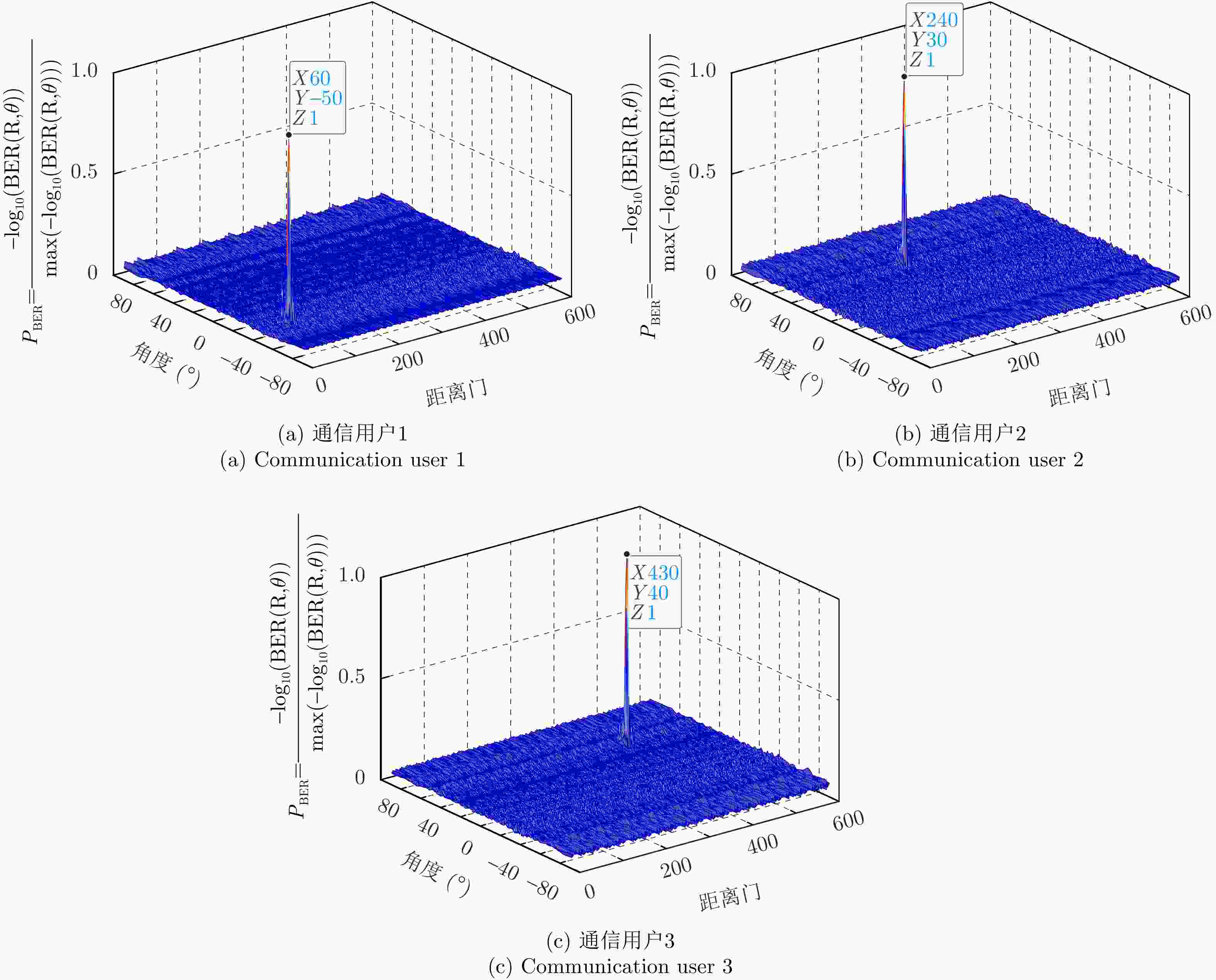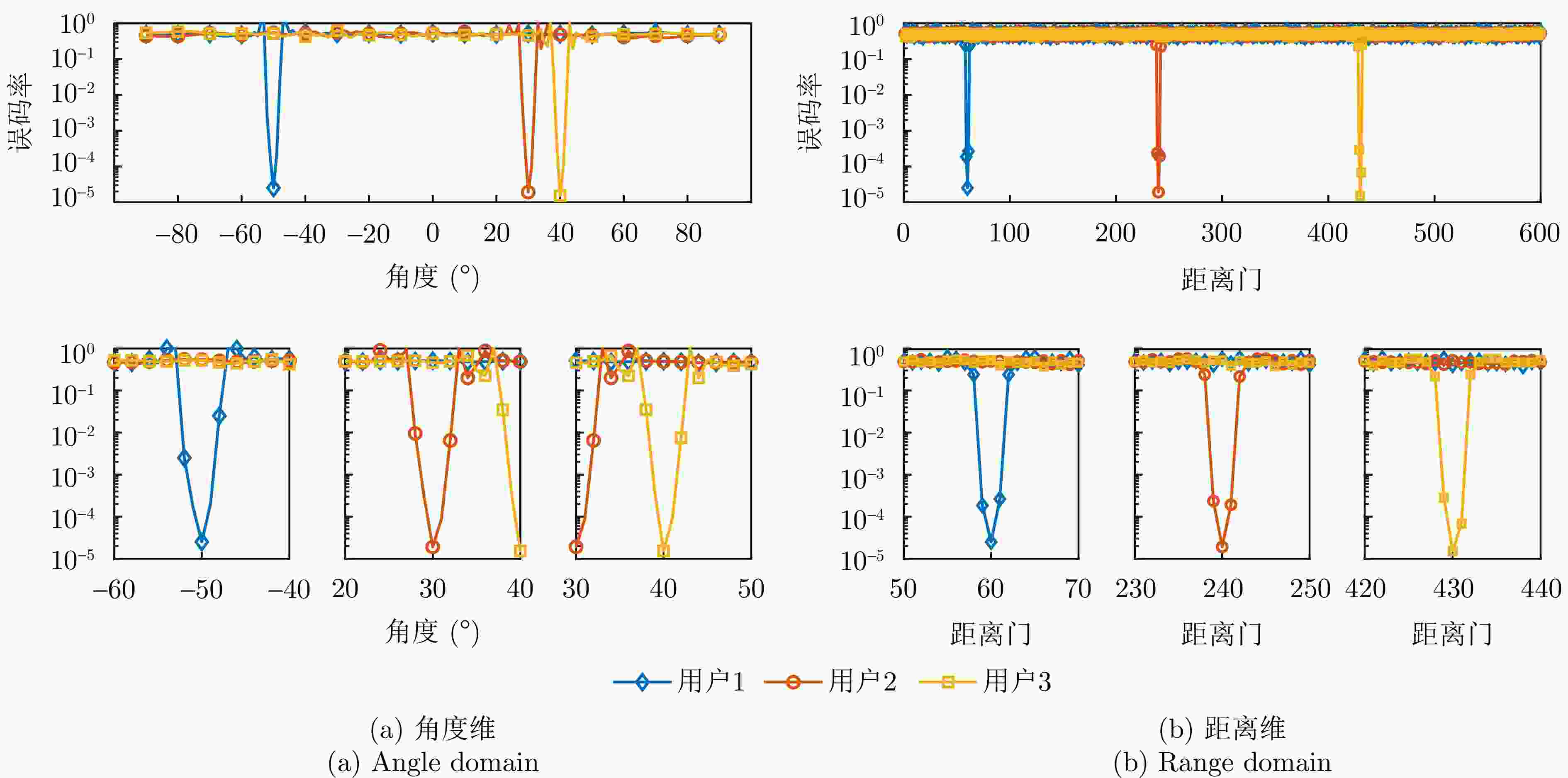Joint Transmit-receive Beam Design of FDA-MIMO Dual-function Radar-communication Systems for Radio-frequency Stealth
-
摘要: 雷达通信一体化(DFRC)系统的射频隐身性能是雷达隐身探测和通信隐蔽传输的关键。然而,传统基于相控阵和MIMO体制的波束形成方案不具备距离维辐射能量控制能力,导致一体化发射信号容易被敌方无源探测系统截获。针对此问题,该文提出一种面向射频隐身的频控阵-多输入多输出(FDA-MIMO)雷达通信一体化发射接收波束联合设计方法。首先,构建基于正交波形生成、频率分集调制和发射波束形成加权的FDA-MIMO一体化发射信号模型,通过匹配滤波和接收波束形成获得雷达等效发射波束图与通信传输信道的距离角度二维表达式。其次,以通信信息嵌入和通信可达速率为约束条件,以雷达目标处的等效发射波束图功率最小化和输出信干噪比最大化为双优化目标函数,建立面向射频隐身的FDA-MIMO雷达通信一体化发射接收波束联合优化模型。最后,提出基于加权均方误差最小化(WMMSE)和共享交替方向乘子法(C-ADMM)的联合优化算法,推导各变量的闭式表达式并结合凸优化算法,实现低复杂度求解。仿真结果表明,该文所提方法的雷达探测与通信传输在距离角度二维平面上均为“点对点”模式,具备良好的射频隐身能力,同时能够提供较高的杂波和干扰抑制性能以及较低的通信误码率。Abstract: Efficient Radio-Frequency (RF) stealth is crucial for Dual-Function Radar-Communication (DFRC) systems that detect radar stealth and con vert communication transmission. However, traditional beamforming schemes based on phased arrays and Multiple-Input Multiple-Output (MIMO) systems lack the ability to control the radiation energy in the range dimension, resulting in the facile interception of integrated transmission signals by enemy-owned passive detection systems. To address this issue, a joint transmit-receive beamforming design for Frequency Diversity Array MIMO (FDA-MIMO) DFRC systems is designed herein to achieve RF stealth. First, an integrated transmission signal model based on orthogonal waveform generation, frequency diversity modulation, and weighted transmission beamforming is constructed. The two-dimensional expression of the distance angle between the radar equivalent transmission beam pattern and the communication transmission channel is obtained through matched filtering and reception beamforming. Second, with communication information embedding and communication reachable rate as constraints, a joint optimization model for FDA-MIMO radar communication integrated transmission and reception beams for RF stealth is established. The model aims to simultaneously minimize the equivalent transmission beam power at the radar target and maximize the output signal-to-noise ratio. Finally, a joint optimization algorithm based on Weighted Mean-Square Error Minimization (WMMSE) and the Consensus Alternating Direction Method of Multiplier (C-ADMM) is proposed. Closed form expressions for each variable are derived and combined with convex optimization algorithms to achieve low-complexity solutions. The simulation results show that radar detection and communication transmission using the proposed method form a “point-to-point” pattern on the two-dimensional plane of range and angle, exhibiting good RF stealth capability. Simultaneously, this method can provide high clutter and interference suppression performance as well as a low communication bit error rate.
-
1 改进稳健接收波束形成(IRRB)算法
1. Improved Robust Received Beamforming (IRRB) algorithm
输入:N, $ {N_{\rm r}} $, E, Q, J, $ J' $, $ \varsigma $, $ \nu $, $ {\rho _{1, 1}} $, $ {\rho _{1, 2}} $, $ {\rho _{1, 3}} $, $ {\rho _{1, 4}} $, $ {\zeta _j} $, $ {\chi _{j, j'}} $, $ \eta $, $ {\theta _t} $, $ {\theta _q} $, $ {\theta _j} $, $ {\varphi _j} $, $ {\stackrel \frown{\theta } _{j, j'}} $, $ {\gamma _t} $, $ {\gamma _q} $, $ {\gamma _j} $。 输出:雷达角度维接收波束形成器$ {{\boldsymbol{e}}^{{\text{opt}}}} $。 步骤1:初始化:$ {{\boldsymbol{e}}^{(0)}} $, $ \left\{ {\vartheta _{j, j'}^{(0)}} \right\} $, $ {h^{(0)}} $, $ \left\{ {\varpi _{j, j'}^{(0)}} \right\} $, $ \mu _t^{(0)} $, $ \left\{ {\mu _{j, j'}^{(0)}} \right\} $, $ \left\{ {\mu _{j, j'}^{'(0)}} \right\} $, $ \left\{ {\eta _{j, j'}^{(0)}} \right\} $。 步骤2:令$ l = {\text{1}} $。 步骤3:利用式(39a)更新$ {{\boldsymbol{e}}^{(l)}} $。 步骤4:利用式(39b)更新$ \left\{ {\vartheta _{j, j'}^{(l)}} \right\} $。 步骤5:利用式(39c)更新$ {h^{(l)}} $。 步骤6:利用式(39d)更新$ \left\{ {\varpi _{j, j'}^{(l)}} \right\} $。 步骤7:利用式(38e)、式(38f)、式(38g)和式(38h)更新$ \mu _t^{(l)} $, $ \left\{ {\mu _{j, j'}^{(l)}} \right\} $, $ \left\{ {\mu _{j, j'}^{'(l)}} \right\} $和$ \left\{ {\eta _{j, j'}^{(l)}} \right\} $。 步骤8:如果$ l \ge N_{{\text{IRRB}}}^{{\text{max}}} $或者$ {\varOmega }_{\text{IRRB}}^{\text{(}l\text{)}}\le {\epsilon}_{\text{IRRB}} $,则停止迭代,输出$ {{\boldsymbol{e}}^{{\text{opt}}}} = {{\boldsymbol{e}}^{{\text{(}}l{\text{)}}}} $。否则,令$ l = l + 1 $,跳转步骤3。其中,
$ \varOmega _{{\text{IRRB}}}^{{\text{(}}l{\text{)}}} = \left| {{{\boldsymbol{e}}^{{\text{(}}l{\text{)H}}}}\left( {{{\boldsymbol{R}}_q} + {{\boldsymbol{R}}_n}} \right){{\boldsymbol{e}}^{{\text{(}}l{\text{)}}}} + \dfrac{\varsigma }{2}{h^{{\text{(}}l{\text{)}}2}} + \dfrac{\nu }{2}{{\left\| {{{\boldsymbol{e}}^{{\text{(}}l{\text{)}}}}} \right\|}^2}} \right| $,$ N_{{\text{IRRB}}}^{{\text{max}}} $和$ {\epsilon}_{\text{IRRB}} $分别表示最大迭代次数和停止门限。2 FDA-MIMO雷达通信一体化发射接收波束联合优化算法
2. Joint optimization algorithm of transmit-receive beam for FDA-MIMO DFRC
输入:N, $ {N_{\rm t}} $, $ {N_{\rm r}} $, $ {N_{{\mathrm{c}},u}} $, $ {N_{{\text{path}}}} $, E, Q, J, U, $ \kappa $, $ {\rho _1} $, $ {\rho _2} $, $ {\rho _3} $, $ {\alpha _{u, l}} $, $ \eta $, $ \beta $, $ {\theta _t} $, $ {\theta _q} $, $ {\theta _j} $, $ {\theta _u} $, $ {R_u} $, $ \phi _{u, l}^{({\mathrm{t}})} $, $ \phi _{u, l}^{({\mathrm{r}})} $, $ {R_t} $, $ {R_q} $, $ {R_{u, l}} $, $ \tau $, $ {\varepsilon _u} $, $ {d_{u, n}} $, $ {b_{u, n}} $, $ {\gamma _t} $, $ {\gamma _q} $, $ {\gamma _j} $。 输出:一体化发射波束形成器$ {{\boldsymbol{T}}^{{\text{opt}}}} $,雷达接收波束形成器$ {{\boldsymbol{u}}^{{\text{opt}}}} $,通信接收波束形成器$ \left\{ {{\boldsymbol{W}}_u^{{\text{opt}}}} \right\} $。 步骤1:初始化:$ {{\boldsymbol{e}}^{(0)}} $, $ {{\boldsymbol{T}}^{(0)}} $, $ {{\boldsymbol{v}}^{(0)}} $, $ \left\{ {{\boldsymbol{q}}_{u, n}^{(0)}} \right\} $, $ \left\{ {L_{u, n}^{(0)}} \right\} $, $ \left\{ {Q_{u, n}^{(0)}} \right\} $, $ \left\{ {\lambda _{u, n}^{(1)(0)}} \right\} $, $ \left\{ {\lambda _{u, n}^{(2)(0)}} \right\} $, $ \left\{ {\lambda _{u, n}^{(3)(0)}} \right\} $。 步骤2:利用式(21)和式(22)计算通信信道$ {{\boldsymbol{H}}_u} $。 步骤3:令$ k = 1 $。 步骤4:利用式(29)计算$ {e_{u, n}} $和$ {w_{u, n}} = 1/{e_{u, n}} $,并利用式(30)更新$ \left\{ {{\boldsymbol{W}}_u^{(k)}} \right\} $。 步骤5:通过算法1更新$ {{\boldsymbol{e}}^{(k)}} $。 步骤6:通过式(46a)、式(46b)和式(46c)获得$ {{\boldsymbol{d}}^{(k)}} $,并根据$ {\boldsymbol{d}} = {\text{vec}}\left( {\boldsymbol{T}} \right) $更新$ {{\boldsymbol{T}}^{(k)}} $。 步骤7:利用式(53)更新$ {{\boldsymbol{v}}^{(k)}} $。 步骤8:利用CVX工具箱求解凸优化模型(55)更新$ \left\{ {{\boldsymbol{q}}_{u, n}^{(k)}} \right\} $。 步骤9:依据$ \sum\nolimits_{u = 1}^U {\sum\nolimits_{n = 1}^N {{{\left| {{L_{u, n}}\left( \partial \right) - {d_{u, n}}{b_{u, n}}} \right|}^2}} } = {\tau ^2} $,通过二分法获得$ {\partial ^{{\text{opt}}}} $,然后利用式(58)更新$ \left\{ {L_{u, n}^{(k)}} \right\} $。 步骤10:依据$ \sum\nolimits_{n = 1}^N {{\omega _{u, n}}{{\left| {{Q_{u, n}}\left( \ell \right) - 1} \right|}^2}} = {\upsilon _u} $,通过二分法获得$ {\ell ^{{\text{opt}}}} $,然后利用式(61)更新$ \left\{ {Q_{u, n}^{(k)}} \right\} $。 步骤11:利用式(62a)、式(62b)和式(62c)更新$ \left\{ {\lambda _{u, n}^{(1)(k)}} \right\} $, $ \left\{ {\lambda _{u, n}^{(2)(k)}} \right\} $和$ \left\{ {\lambda _{u, n}^{(3)(k)}} \right\} $。 步骤12:如果$ k \ge N_{{\text{C-ADMM}}}^{{\text{max}}} $,则停止迭代,输出$ {{\boldsymbol{T}}^{{\text{opt}}}} = {{\boldsymbol{T}}^{{\text{(}}k{\text{)}}}} $, $ {{\boldsymbol{u}}^{{\text{opt}}}} = {{\boldsymbol{e}}^{{\text{(}}k{\text{)}}}} \otimes {{\boldsymbol{v}}^{{\text{(}}k{\text{)}}}} $, $ {\boldsymbol{W}}_u^{{\text{opt}}} = {\boldsymbol{W}}_u^{{\text{(}}k{\text{)}}} $。否则,令$ k = k + 1 $,跳转步骤4。
其中,$ N_{{\text{C-ADMM}}}^{{\text{max}}} $表示最大迭代次数。 -
[1] LIU Fan, CUI Yuanhao, MASOUROS C, et al. Integrated sensing and communications: Toward dual-functional wireless networks for 6G and beyond[J]. IEEE Journal on Selected Areas in Communications, 2022, 40(6): 1728–1767. doi: 10.1109/JSAC.2022.3156632. [2] QI Chenhao, CI Wei, ZHANG Jinming, et al. Hybrid beamforming for millimeter wave MIMO integrated sensing and communications[J]. IEEE Communications Letters, 2022, 26(5): 1136–1140. doi: 10.1109/LCOMM.2022.3157751. [3] NING Boyu, MEI Weidong, ZHU Lipeng, et al. Codebook design and performance analysis for wideband beamforming in terahertz communications[J]. IEEE Transactions on Wireless Communications, 2024, 23(12): 19618–19633. doi: 10.1109/TWC.2024.3485536. [4] SHI Chenguang, WANG Fei, SELLATHURAI M, et al. Power minimization-based robust OFDM radar waveform design for radar and communication systems in coexistence[J]. IEEE Transactions on Signal Processing, 2018, 66(5): 1316–1330. doi: 10.1109/TSP.2017.2770086. [5] WU Jiale, SHI Chenguang, ZHANG Weiwei, et al. Joint beamforming design and power control game for a MIMO radar system in the presence of multiple jammers[J]. IEEE Transactions on Aerospace and Electronic Systems, 2024, 60(1): 759–773. doi: 10.1109/TAES.2023.3328804. [6] HE Rongrong, LI Guoxin, CHEN Jin, et al. Joint power and beamformer optimization in multi-antenna relay covert system: Exploiting public users as shelter[J]. IEEE Transactions on Wireless Communications, 2025, 24(1): 385–400. doi: 10.1109/TWC.2024.3492802. [7] 时晨光, 丁琳涛, 汪飞, 等. 面向射频隐身的组网雷达多目标跟踪下射频辐射资源优化分配算法[J]. 电子与信息学报, 2021, 43(3): 539–546. doi: 10.11999/JEIT200636.SHI Chenguang, DING Lintao, WANG Fei, et al. Radio frequency stealth-based optimal radio frequency resource allocation algorithm for multiple-target tracking in radar network[J]. Journal of Electronics & Information Technology, 2021, 43(3): 539–546. doi: 10.11999/JEIT200636. [8] LIU Xinyu, YUAN Ye, ZHANG Tianxian, et al. Integrated transmit waveform and RIS phase shift design for LPI detection and communication[J]. IEEE Transactions on Wireless Communications, 2024, 23(6): 5663–5679. doi: 10.1109/TWC.2023.3327685. [9] WANG Wenqin. Potential transmit beamforming schemes for active LPI radars[J]. IEEE Aerospace and Electronic Systems Magazine, 2017, 32(5): 46–52. doi: 10.1109/MAES.2017.150259. [10] 王祥丽, 易伟, 孔令讲. 基于多目标跟踪的相控阵雷达波束和驻留时间联合分配方法[J]. 雷达学报, 2017, 6(6): 602–610. doi: 10.12000/JR17045.WANG Xiangli, YI Wei, and KONG Lingjiang. Joint beam selection and dwell time allocation for multi-target tracking in phased array radar system[J]. Journal of Radars, 2017, 6(6): 602–610. doi: 10.12000/JR17045. [11] YAN Junkun, PU Wenqiang, DAI Jinhui, et al. Resource allocation for search and track application in phased array radar based on Pareto bi-objective optimization[J]. IEEE Transactions on Vehicular Technology, 2019, 68(4): 3487–3499. doi: 10.1109/TVT.2019.2894960. [12] YUAN Ye, YI Wei, and KONG Lingjiang. Joint tracking sequence and dwell time allocation for multi-target tracking with phased array radar[J]. Signal Processing, 2022, 192: 108374. doi: 10.1016/j.sigpro.2021.108374. [13] LAWRENCE D E. Low probability of intercept antenna array beamforming[J]. IEEE Transactions on Antennas and Propagation, 2010, 58(9): 2858–2865. doi: 10.1109/TAP.2010.2052573. [14] BASIT A, QURESHI I M, KHAN W, et al. Hybridization of cognitive radar and phased array radar having low probability of intercept transmit beamforming[J]. International Journal of Antennas and Propagation, 2014, 2014: 129172. doi: 10.1155/2014/129172. [15] 杨少委. 正交波形MIMO雷达射频隐身技术研究[D]. [博士论文], 电子科技大学, 2015.YANG Shaowei. Research on radio frequency stealth technology for orthogonal waveform MIMO radar[D]. [Ph.D. dissertation], University of Electronic Science and technology of China, 2015. [16] CHEN Kejin, YANG Shiwen, CHEN Yikai, et al. Transmit beamforming based on 4-D antenna arrays for low probability of intercept systems[J]. IEEE Transactions on Antennas and Propagation, 2020, 68(5): 3625–3634. doi: 10.1109/TAP.2019.2963593. [17] DING Lintao, SHI Chenguang, and ZHOU Jianjiang. Joint beampattern design and online route planning for multitarget tracking in airborne radar system[J]. IEEE Transactions on Aerospace and Electronic Systems, 2024, 60(1): 774–788. doi: 10.1109/TAES.2023.3328799. [18] BENDARY A, ABDELAZIZ A, and KOKSAL C E. Achieving positive covert capacity over MIMO AWGN channels[J]. IEEE Journal on Selected Areas in Information Theory, 2021, 2(1): 149–162. doi: 10.1109/JSAIT.2021.3053862. [19] ZHENG Tongxing, WANG Huiming, NG D W K, et al. Multi-antenna covert communications in random wireless networks[J]. IEEE Transactions on Wireless Communications, 2019, 18(3): 1974–1987. doi: 10.1109/TWC.2019.2900915. [20] GAO Weijun, CHEN Yi, HAN Chong, et al. Distance-adaptive absorption peak modulation (DA-APM) for terahertz covert communications[J]. IEEE Transactions on Wireless Communications, 2021, 20(3): 2064–2077. doi: 10.1109/TWC.2020.3038902. [21] HADZI-VELKOV Z, PEJOSKI S, and ZLATANOV N. Achieving near ideal covertness in NOMA systems with channel inversion power control[J]. IEEE Communications Letters, 2022, 26(11): 2542–2546. doi: 10.1109/LCOMM.2022.3195544. [22] NGUYEN T T, LUONG N C, FENG Shaohan, et al. Jamming-based covert communication for rate-splitting multiple access[J]. IEEE Transactions on Vehicular Technology, 2023, 72(8): 11074–11079. doi: 10.1109/TVT.2023.3259963. [23] YANG Liang, ZHANG Wei, BITHAS P S, et al. Covert transmission and secrecy analysis of RS-RIS-NOMA-Aided 6G wireless communication systems[J]. IEEE Transactions on Vehicular Technology, 2023, 72(8): 10659–10670. doi: 10.1109/TVT.2023.3262943. [24] WU Haozheng, JIN Biao, XU Zhaoyang, et al. Waveform design and signal processing for integrated radar-communication system based on frequency diversity array[J]. Digital Signal Processing, 2023, 133: 103839. doi: 10.1016/j.dsp.2022.103839. [25] 兰岚, 廖桂生, 许京伟, 等. 基于频率分集阵列的多功能一体化波形设计与信号处理方法[J]. 雷达学报, 2022, 11(5): 850–870. doi: 10.12000/JR22163.LAN Lan, LIAO Guisheng, XU Jingwei, et al. Waveform design and signal processing method of a multifunctional integrated system based on a frequency diverse array[J]. Journal of Radars, 2022, 11(5): 850–870. doi: 10.12000/JR22163. [26] XU Jingwei, LIAO Guisheng, and SO H C. Space-time adaptive processing with vertical frequency diverse array for range-ambiguous clutter suppression[J]. IEEE Transactions on Geoscience and Remote Sensing, 2016, 54(9): 5352–5364. doi: 10.1109/TGRS.2016.2561308. [27] LIU Qi, XU Jingwei, DING Zhi, et al. Target localization with jammer removal using frequency diverse array[J]. IEEE Transactions on Vehicular Technology, 2020, 69(10): 11685–11696. doi: 10.1109/TVT.2020.3016948. [28] LAN Lan, XU Jingwei, LIAO Guisheng, et al. Suppression of mainbeam deceptive jammer with FDA-MIMO radar[J]. IEEE Transactions on Vehicular Technology, 2020, 69(10): 11584–11598. doi: 10.1109/TVT.2020.3014689. [29] WANG Liu, WANG Wenqin, GUAN Haoliang, et al. LPI property of FDA transmitted signal[J]. IEEE Transactions on Aerospace and Electronic Systems, 2021, 57(6): 3905–3915. doi: 10.1109/TAES.2021.3083402. [30] JIA Wenkai, JAKOBSSON A, and WANG Wenqin. Optimal frequency offset selection for FDA-MIMO beampattern design in the range-angle plane[J]. IEEE Signal Processing Letters, 2024, 31: 316–320. doi: 10.1109/LSP.2023.3348307. [31] GONG Pengcheng, ZHANG Zhuoyu, WU Yuntao, et al. Joint design of transmit waveform and receive beamforming for LPI FDA-MIMO radar[J]. IEEE Signal Processing Letters, 2022, 29: 1938–1942. doi: 10.1109/LSP.2022.3205206. [32] 刘德顺, 夏德平, 陈露, 等. 基于神经网络的FDA-MIMO低截获发射波形和接收波束形成联合设计[J]. 雷达学报(中英文), 2024, 13(6): 1239–1251. doi: 10.12000/JR24140.LIU Deshun, XIA Deping, CHEN Lu, et al. Joint design of LPI transmit waveform and receive beamforming based on neural networks for FDA-MIMO[J]. Journal of Radars, 2024, 13(6): 1239–1251. doi: 10.12000/JR24140. [33] CHEN Xiaoming, NG D W K, GERSTACKER W H, et al. A Survey on multiple-antenna techniques for physical layer security[J]. IEEE Communications Surveys & Tutorials, 2017, 19(2): 1027–1053. doi: 10.1109/COMST.2016.2633387. [34] 杨宇晓, 高萍. 多层多参数多项加权分数阶傅里叶变换复合调制通信信号设计方法[J]. 电子与信息学报, 2023, 45(4): 1192–1200. doi: 10.11999/JEIT220266.YANG Yuxiao and GAO Ping. Design method of multi-layer multi-parameter multi-term weighted-type fractional fourier transform composite modulation communication signal[J]. Journal of Electronics & Information Technology, 2023, 45(4): 1192–1200. doi: 10.11999/JEIT220266. [35] YAN Shihao, ZHOU Xiangyun, HU Jinsong, et al. Low probability of detection communication: Opportunities and challenges[J]. IEEE Wireless Communications, 2019, 26(5): 19–25. doi: 10.1109/MWC.001.1900057. [36] JIAN Jiangwei, WANG Wenqin, BASIT A, et al. Physical layer security for frequency diverse array-based dual-hop spatial modulation[J]. IEEE Transactions on Wireless Communications, 2023, 22(11): 7565–7579. doi: 10.1109/TWC.2023.3253214. [37] JIAN Jiangwei, WANG Wenqin, HUANG Bang, et al. MIMO-FDA communications with frequency offsets index modulation[J]. IEEE Transactions on Wireless Communications, 2024, 23(5): 4580–4595. doi: 10.1109/TWC.2023.3320129. [38] ZHANG Yuchen, ZHANG Yichi, WANG Jianquan, et al. Distance-angle beamforming for covert communications via frequency diverse array: Toward two-dimensional covertness[J]. IEEE Transactions on Wireless Communications, 2023, 22(12): 8559–8574. doi: 10.1109/TWC.2023.3263939. [39] GONG Pengcheng, XU Kaiyan, WU Yuntao, et al. Optimization of LPI-FDA-MIMO radar and MIMO communication for spectrum coexistence[J]. IEEE Wireless Communications Letters, 2023, 12(6): 1076–1080. doi: 10.1109/LWC.2023.3261419. [40] LIU Fan, ZHOU Longfei, MASOUROS C, et al. Toward dual-functional radar-communication systems: Optimal waveform design[J] IEEE Transactions on Signal Processing, 2018, 66(16): 4264–4279. doi: 10.1109/TSP.2018.2847648. [41] LI Bo, PETROPULU A P, and TRAPPE W. Optimum Co-design for spectrum sharing between matrix completion based MIMO radars and a MIMO communication system[J]. IEEE Transactions on Signal Processing, 2016, 64(17): 4562–4575. doi: 10.1109/TSP.2016.2569479. [42] 刘凡, 袁伟杰, 原进宏, 等. 雷达通信频谱共享及一体化: 综述与展望[J]. 雷达学报, 2021, 10(3): 467–484. doi: 10.12000/JR20113.LIU Fan, YUAN Weijie, YUAN Jinhong, et al. Radar-communication spectrum sharing and integration: Overview and prospect[J]. Journal of Radars, 2021, 10(3): 467–484. doi: 10.12000/JR20113. [43] 王文钦, 陈慧, 郑植, 等. 频控阵雷达技术及其应用研究进展[J]. 雷达学报, 2018, 7(2): 153–166. doi: 10.12000/JR18029.WANG Wenqin, CHEN Hui, ZHENG Zhi, et al. Advances on frequency diverse array radar and its applications[J]. Journal of Radars, 2018, 7(2): 153–166. doi: 10.12000/JR18029. [44] HASSANIEN A, AMIN M G, ZHANG Y D, et al. Dual-function radar-communications: Information embedding using sidelobe control and waveform diversity[J]. IEEE Transactions on Signal Processing, 2016, 64(8): 2168–2181. doi: 10.1109/TSP.2015.2505667. [45] 王文钦, 张顺生. 频控阵雷达技术研究进展综述[J]. 雷达学报, 2022, 11(5): 830–849. doi: 10.12000/JR22141.WANG Wenqin and ZHANG Shunsheng. Recent advances in frequency diverse array radar techniques[J]. Journal of Radars, 2022, 11(5): 830–849. doi: 10.12000/JR22141. [46] YIN Haifan, GESBERT D, FILIPPOU M, et al. A coordinated approach to channel estimation in large-scale multiple-antenna systems[J]. IEEE Journal on Selected Areas in Communications, 2013, 31(2): 264–273. doi: 10.1109/JSAC.2013.130214. [47] SHI Qingjiang, RAZAVIYAYN M, LUO Zhiquan, et al. An iteratively weighted MMSE approach to distributed sum-utility maximization for a MIMO interfering broadcast channel[J]. IEEE Transactions on Signal Processing, 2011, 59(9): 4331–4340. doi: 10.1109/TSP.2011.2147784. [48] CHENG Ziyang and LIAO Bin. QoS-aware hybrid beamforming and DOA estimation in multi-carrier dual-function radar-communication systems[J]. IEEE Journal on Selected Areas in Communications, 2022, 40(6): 1890–1905. doi: 10.1109/JSAC.2022.3155529. [49] PU Wenqiang, XIAO Jinjun, ZHANG Tao, et al. A penalized inequality-constrained approach for robust beamforming with DoF limitation[J]. Signal Process, 2019, 202: 108746. doi: 10.1016/j.sigpro.2022.108746. [50] CHENG Ziyang, HAN Chunlin, LIAO Bin, et al. Communication-aware waveform design for MIMO radar with good transmit beampattern[J]. IEEE Transactions on Signal Processing, 2018, 66(21): 5549–5562. doi: 10.1109/TSP.2018.2868042. [51] WU Haozheng, JIN Biao, ZHANG Zhenkai, et al. Robust transmit beamforming in MIMO dual-functional radar-communication systems for unidirectional multi-user communication[J]. IEEE Transactions on Vehicular Technology, 2025, 74(3): 4307–4318. doi: 10.1109/TVT.2024.3490556. -



 作者中心
作者中心 专家审稿
专家审稿 责编办公
责编办公 编辑办公
编辑办公
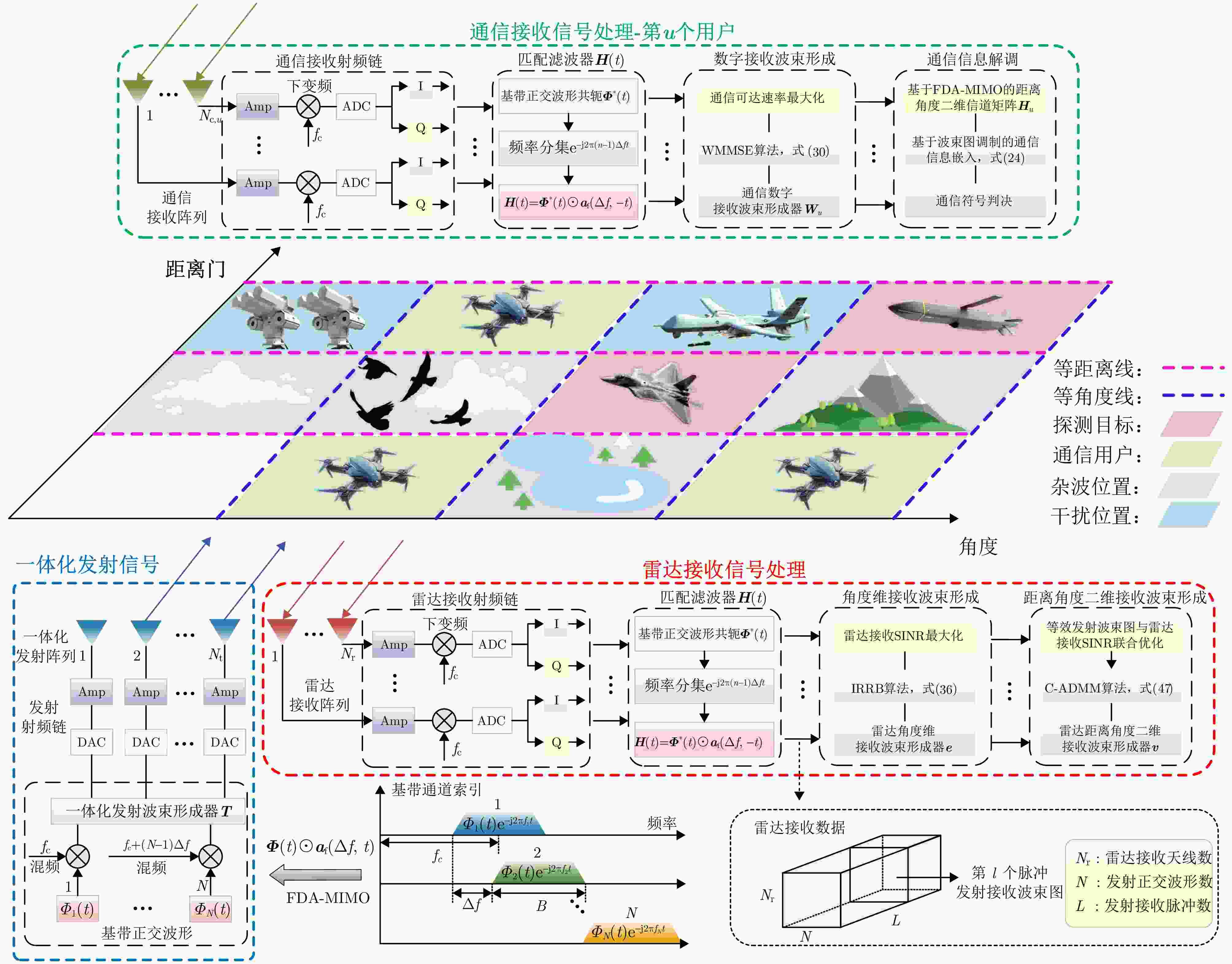
 下载:
下载:
